Mastering Honeycomb Toffee: A Complete Guide
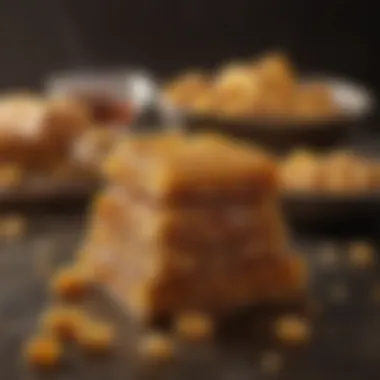
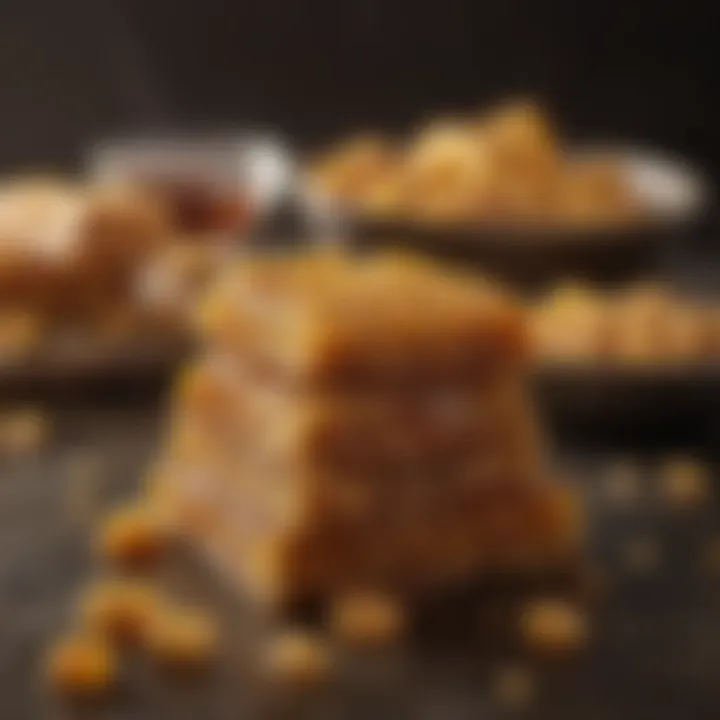
Intro
Honeycomb toffee is a cherished confection that captivates taste buds with its airy crunch and sweet flavor. It finds its origins in many cultures, often serving as a nostalgic treat. This guide serves to illuminate the multi-faceted world of honeycomb toffee, dissecting its history, the science that creates its unique texture, and the various methods that home cooks can employ to achieve perfection.
Many people adore honeycomb toffee for its versatility. It can be enjoyed alone, incorporated into desserts, or even used as an ingredient in more complex dishes. Understanding the nuances of this treat is essential for anyone aiming to master its creation.
Each section of this guide is designed to offer detailed insights, from the ingredients needed to practical cooking tips. Whether you are a novice baker or someone with more experience looking to refine your technique, you will find valuable information within these pages. Let’s embark on this journey into the art and science of honeycomb toffee.
Foreword to Honeycomb Toffee
Honeycomb toffee, a confectionery marvel, captivates both the eyes and the palate. Understanding its significance helps one appreciate its complexity and culinary artistry. This section aims to explore what honeycomb toffee is and why it is a treasured treat in various cultures.
Defining Honeycomb Toffee
Honeycomb toffee is primarily known for its airy, crisp texture, created by the combination of sugar, golden syrup, and bicarbonate of soda. When the sugar mixture is heated and subsequently reacts with the baking soda, it expands rapidly. This chemical reaction results in the formation of tiny bubbles, giving honeycomb toffee its characteristic lightness. The color typically ranges from golden to amber, reflecting the cooking time of sugars involved.
The confection is often associated with both childhood nostalgia and culinary creativity. It can be consumed alone or serve as a component in various desserts.
Cultural Significance
Across different cultures, honeycomb toffee occupies a unique place. In the UK, it is commonly enjoyed in a chocolate-covered form as "sponge candy" or "cinder toffee." In Australia, a similar product known as "honeycomb" is favored in many sweet treats.
The cultural relevance extends beyond mere consumption. Honeycomb toffee often appears during festivals and celebrations, marking special occasions. The act of making honeycomb toffee can also be seen as a shared experience among family members, strengthening bonds through the simple pleasure of cooking.
"Honeycomb toffee transcends borders, uniting those who savor it in cultural appreciation and regional variations."
By exploring its definitions and cultural significance, one can gain a deeper understanding of honeycomb toffee, making it more than just a sweet indulgence. This confectionery serves as a gateway into culinary traditions and innovations that merit further examination.
Historical Background
Understanding the historical background of honeycomb toffee offers valuable context to its current popularity. This confectionery not only charms with its taste but also carries rich stories and traditions that reflect cultural practices over time. The journey of honeycomb toffee is a study of the adaptation of simple ingredients into a beloved treat, intertwining culinary innovation with social rituals.
Origins of Honeycomb
The origins of honeycomb date back several centuries and vary across different cultures. Historical records indicate that similar confections have been made as early as the medieval era. The base components, primarily sugar and perhaps honey, have been staples in many societies. Evidence from ancient civilizations, particularly in the Middle East and Asia, shows that the blending of sugar and air to create a light, airy texture has long been appreciated.
In Europe, this treat began gaining popularity around the 19th century, especially in England and Ireland. The introduction of bicarbonate of soda to the mix during this period marked a turning point, allowing for a quicker and more consistent production of honeycomb toffee. Each region adopted and adapted methods, leading to diverse variations in texture and flavor.
Furthermore, honeycomb toffee's name varies from country to country, reflecting local traditions. For instance, it is known as "cinder toffee" in parts of the UK. This variety of names and recipes indicates a rich tapestry of culinary heritage, influencing how modern recipes are approached.
Evolution of Recipes
The evolution of honeycomb toffee recipes demonstrates how culinary practices can transform over time. Initially, recipes were passed down orally, preserving regional tastes and techniques. As modernization progressed, printed cookbooks began to document these delicious creations, making them accessible to a wider audience.
Today, the foundation of honeycomb toffee remains the same, but the approach to making it has varied significantly. With the advent of technology, home cooks can now experiment with precision and convenience using kitchen appliances that allow for better control of processes like heating and mixing. This flexibility has led to numerous adaptations and innovations in recipe formulations.
Dietary preferences have also had an impact on the evolution of honeycomb toffee. The rise of veganism and gluten-free currents have prompted many recipe developers to think outside the box. Innovations now include alternatives such as coconut sugar or agave syrup, making honeycomb accessible to various dietary needs without compromising the delightful texture or taste.
The evolution of honeycomb toffee is a testament to human creativity in the kitchen, demonstrating how traditions adapt and thrive in changing times.
In summary, the historical background of honeycomb toffee presents a narrative of cultural exchange and culinary advancement. From its ancient roots to modern adaptations, honeycomb toffee continues to capture the imagination of chefs and home bakers alike, serving as a reminder of the delightful impact sugar can have on our palates.
The Science of Honeycomb Toffee
Understanding the science behind honeycomb toffee is vital for achieving the desired texture and flavor. The interplay of ingredients creates the unique characteristics of this confectionery. Each component plays a significant role in not just taste, but also in the final product's structure. Knowing the chemistry involved can help avoid common mistakes and lead to a more successful candy-making experience.


Ingredients and Their Roles
Sugars
Sugars are the backbone of honeycomb toffee, providing sweetness and structure. Their primary function is to caramelize, which imparts flavor and color. Common types of sugar used are granulated sugar and light corn syrup. Granulated sugar is crucial due to its simple structure, which allows for easier melting.
The key characteristic of sugars is their ability to undergo the Maillard reaction, a chemical reaction that enhances flavor as they heat. This makes sugars a beneficial choice for crafting honeycomb toffee. However, one downside is that sugars can easily burn if temperatures are not monitored. This could lead to bitterness in the final product with changes in flavor.
Acids
Acids serve an essential purpose in the candy-making process, as they help stabilize the mixture. Ingredients like vinegar or lemon juice can lower the pH, ensuring that the sugar does not crystallize when heated. This control over crystallization is important in achieving a smooth, airy texture.
A vital aspect of acids is their ability to work with sugars to create a more complex flavor. The inclusion of acids presents a fine line: too much can spoil the taste, while too little may lead to crystallization issues. Thus, judicious use is recommended.
Baking Soda
Baking soda is another critical ingredient in honeycomb toffee. It acts as a leavening agent, creating the characteristic bubbles in the final product. When heated with sugar, it produces carbon dioxide gas, which expands the mixture and gives honeycomb its light, airy texture.
The unique feature of baking soda is its immediate reaction when combined with heat. This rapid expansion is key to transforming the molten sugar into a fluffy treat. However, too much baking soda can create an overly coarse texture, so it is essential to measure precisely for optimal results.
Chemical Reactions and Texture
The texture of honeycomb toffee directly results from various chemical reactions during cooking. The heating of sugars initiates the melting process, followed by caramelization. As the sugar reaches higher temperatures, it transforms into a syrup, unlocking complex flavors.
The combination of acids and baking soda induces a reaction that creates thousands of small bubbles in the syrup. These bubbles solidify as the mixture cools, embedding themselves within the toffee and resulting in its iconic crunchy texture.
The perfection of honeycomb toffee lies in carefully managing temperatures and a precise balance of ingredients. Mastering these elements leads to a delightful confection that is both sweet and satisfying.
In summary, the science of honeycomb toffee is a perfect balance of sugars, acids, and baking soda. It is this delicate interplay that determines the final outcome. Understanding each ingredient's role and behavior during the cooking process is vital for any culinary enthusiast looking to master this confection.
Preparation Techniques
Preparation techniques are vital in the art of making honeycomb toffee. They determine the quality, texture, and flavor of the final product. Each step requires careful attention to detail and a clear understanding of the science involved. By mastering these techniques, one can refine their skills and achieve desired results consistently.
Essential Equipment
Investing in the right equipment is essential for successful honeycomb toffee preparation. Key items include:
- Heavy-bottomed saucepan: This helps distribute heat evenly, preventing the sugar from burning.
- Candy thermometer: An accurate thermometer allows you to monitor the temperature of the sugar, ensuring it reaches the correct stage for optimal texture.
- Whisk: A sturdy whisk helps incorporate air into the mixture when adding baking soda, contributing to the toffee's signature texture.
- Parchment paper: Lining your baking tray with parchment paper makes it easier to remove the toffee once set.
- Spatula: A silicone or wooden spatula is ideal for stirring hot mixtures without scratching the pan's surface.
Each piece of equipment plays a specific role in the process and enhances the overall outcome of your honeycomb toffee.
Step-by-Step Guide to Making Honeycomb Toffee
Making honeycomb toffee may seem daunting, but by following a structured approach, you can simplify the process.
- Gather ingredients: You will need sugar, corn syrup, baking soda, and water. Ensure all ingredients are ready before starting to minimize delays.
- Prepare equipment: Line a baking tray with parchment paper and set aside.
- Combine ingredients: In a saucepan, mix sugar, corn syrup, and water. Stir over medium heat until the sugar dissolves completely.
- Cook the mixture: Continue cooking without stirring until it reaches a temperature of about 300°F (149°C). This is the hard crack stage.
- Add baking soda: Quickly remove the pan from heat and whisk in baking soda. The mixture will froth and expand. Stir until combined.
- Pour and set: Immediately pour the mixture onto the prepared tray. Allow it to cool and harden completely before breaking it into pieces.
By adhering to this step-by-step guide, you can minimize errors and achieve a delightful batch of honeycomb toffee with enjoyable texture.
Variations in Preparation
Different approaches to preparing honeycomb toffee can enhance its versatility in both flavor and texture.
Classic Methods
Classic methods often lean on traditional recipes passed down through generations. These techniques emphasize simplicity and authenticity. One key characteristic is the precise timing during the cooking phase, which ensures the sugar reaches the correct temperature for crunchiness. The benefit of this method is the rich flavor derived from using only basic ingredients. However, it may limit creativity, as it typically does not incorporate modern flavor options.
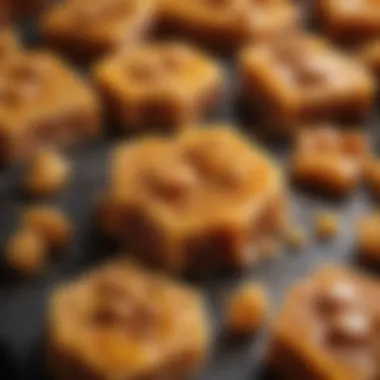
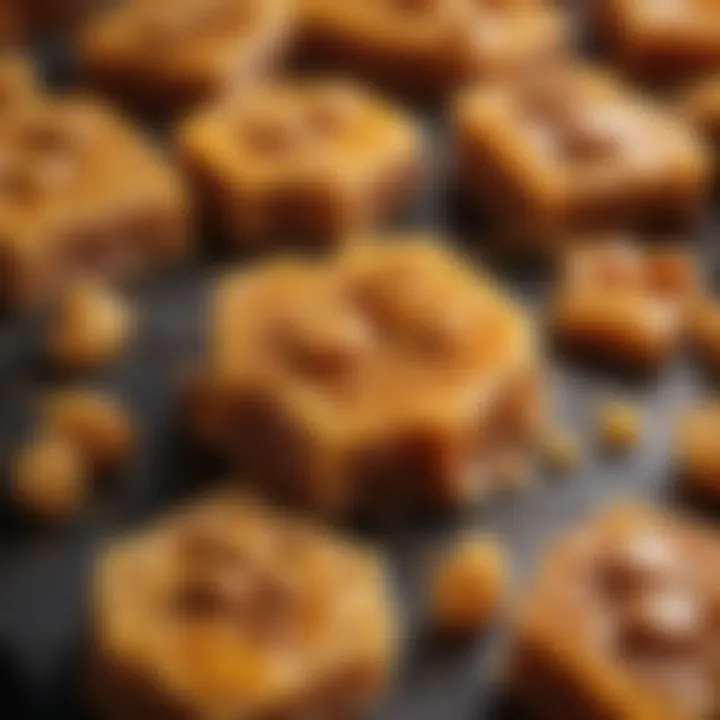
Modern Twists
Modern twists represent a contemporary take on honeycomb toffee that embraces innovation. This might include the integration of unique flavors such as matcha or chai spices. A main characteristic of these variations is the introduction of unexpected ingredients that excite the palate. Such methods provide opportunities to adapt for dietary needs, such as gluten-free or vegan options. The advantage here lies in the ability to create personalized treats that appeal to diverse audiences. However, balancing these new elements requires careful experimentation to maintain the signature texture and taste.
Ultimately, the choice between classic methods and modern twists boils down to individual preference and the desired end results.
Common Mistakes in Making Honeycomb Toffee
When delving into the process of creating honeycomb toffee, it is essential to acknowledge the potential pitfalls that can arise. Understanding these common mistakes not only helps one avoid frustrations but also elevates the quality of the finished product. This section emphasizes the importance of careful attention to detail during the preparation of honeycomb toffee. A single misstep can drastically affect the flavor, texture, and overall success of the confectionery. Here we will discuss the primary mistakes that home cooks often face when attempting to perfect this delightful treat.
Overcooking or Undercooking
The balance between overcooking and undercooking is one of the most critical factors in honeycomb toffee preparation. Each background needs specific timings for proper caramelization of the sugars. Overcooking can lead to a bitterness, while undercooking often results in a sticky mess that is hard to work with.
To ensure the ideal texture, aim for a golden amber color, which usually indicates that the sugars have reached the right temperature. Utilizing a candy thermometer can be highly beneficial in this situation. The target temperature for honeycomb toffee is typically between 300°F (149°C) and 310°F (154°C). If you do not have a thermometer, watch for a change in color and a slight hardening when dripped into cold water.
Baking Soda Miscalculations
Baking soda plays a crucial role in creating the distinct texture of honeycomb toffee. This ingredient acts as a leavening agent, leading to the formation of bubbles during the cooking process. However, adding too much or too little baking soda leads to undesirable results.
Too much baking soda can cause the toffee to become excessively airy and crumbly, while too little results in a denser texture. The standard measurement for most recipes is around one teaspoon for a typical batch. For best practices, ensure to measure accurately and add it at the right moment—after the caramel has been cooked but before it sets. This timing is crucial for achieving the right aeration.
Humidity and Temperature Issues
Environmental factors also significantly affect the making of honeycomb toffee. High humidity can introduce moisture into the mixture, creating a problem with crystallization. This can lead to a final product that lacks the intended crispness and instead turns out chewy or tacky.
A cool, dry day is ideal for candy making. If conditions are not optimal, consider using an air-conditioned room to make toffee. Monitoring room temperature can help to decrease humidity levels, improving the final outcome of the treat.
In summary, recognizing these common mistakes when making honeycomb toffee is vital for success in this culinary endeavor. Focus on cooking times, accurate measurements of baking soda, and the influence of environmental conditions to achieve the perfect texture and flavor every time.
Creative Uses for Honeycomb Toffee
Honeycomb toffee is not just a treat on its own; its versatility enhances various dishes and confections. The creative applications of this unique confectionery showcase its adaptability and relevance in both classic and contemporary culinary practices. From adding texture to traditional desserts to offering an exciting twist in modern recipes, honeycomb toffee brings a distinct flavor and visual appeal.
In Confectionery
In the realm of confectionery, honeycomb toffee serves as a delightful element that elevates numerous sweets. When integrated into chocolates, it contributes a contrasting crunch that complements the smoothness of the chocolate. This textural interplay creates a sensory experience that appeals to broader audiences, making it a sought-after addition in artisan shops.
Moreover, honeycomb can be incorporated into lollipops, where it provides a sweet surprise as it breaks apart when bitten. Many confectioners emphasize the importance of balancing sweetness, ensuring that the honeycomb’s sugariness does not overwhelm other flavors. Utilizing honeycomb toffee in confectionery not only enhances flavor but also showcases impressive craftsmanship, often distinguishing high-quality products in the market.
In Desserts
Desserts benefit significantly from the addition of honeycomb toffee, whether as a topping or an ingredient. The unique characteristics of honeycomb, such as its crunchy texture and airy composition, provide depth and interest to a variety of dishes.
Chocolate Coatings
Using honeycomb toffee for chocolate coatings is a popular method that adds both visual appeal and taste. Coating bites of honeycomb in chocolate creates a delightful contrast between the rich, creamy chocolate and the light, crunchy toffee. As a result, this pairing becomes a favored choice for many because it brings a balance of flavors. The sweetness of the honeycomb and the richness of chocolate can create a harmonious blend that is hard to resist.
Additionally, chocolate-coated honeycomb can be used as a garnish. Crushed pieces scattered over desserts lend a decorative finish that tempts the eye. However, one must consider that while chocolate adds richness, it can also make the final product heavier in taste. As such, a thoughtful approach to quantity and balance is necessary to maintain the intended flavor profile.
Layered Cakes
Layered cakes can gain complexity from the addition of honeycomb toffee. Its crystalline structure makes it an exceptional filling or decoration, breaking up the smoothness of buttercream or ganache. This integration not only enhances texture but also introduces an unexpected burst of flavor, making every bite unique.
One key characteristic of layered cakes featuring honeycomb toffee is the dynamic interplay of textures. The crunchiness of the toffee contrasts with the softness of cake layers, creating an engaging eating experience.
However, the addition of honeycomb to muffins presents some challenges, primarily concerning its stability. The toffee can become sticky when exposed to moisture, which may affect the cake's texture over time. To mitigate this, it is advisable to incorporate honeycomb just prior to serving or use it primarily for decoration.

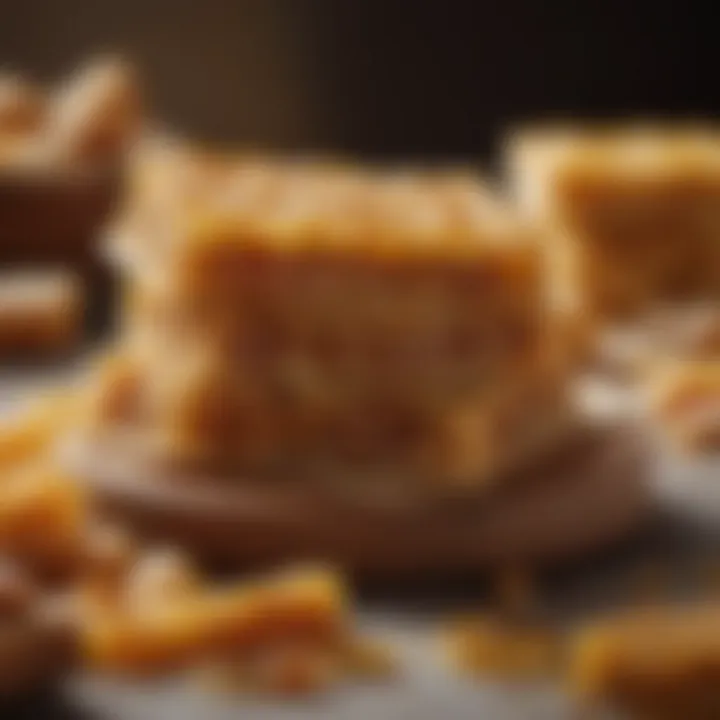
Honeycomb Toffee in Popular Culture
Honeycomb toffee holds a distinct place in popular culture, manifesting itself in various forms of media, literature, and culinary traditions. This confectionery is not merely a sweet treat; it reflects regional variations and is embedded in the collective consciousness of diverse communities. It serves as a bridge between generations, illustrating how food can transcend mere sustenance to become a medium of expression and connection.
Literary References
In literature, honeycomb toffee appears as more than just a sweet indulgence. Writers often use it to evoke nostalgia, childhood memories, or even metaphorical sweetness in character interactions. For instance, in the classic children's book "Charlie and the Chocolate Factory" by Roald Dahl, the allure of sweets captures the imagination of readers and highlights the wonder associated with confectionery. Honeycomb toffee, with its crunchy texture and airy surface, is symbolic of the joy experienced with small delights in life.
Additionally, authors might reference honeycomb toffee to emphasize themes such as creativity and the celebration of imperfections in life. In exploring culinary journeys, honeycomb toffee provides an avenue for characters to discover not just flavors but also richer life experiences. Thus, it serves both as a narrative device and as a tangible treat that connects readers to the joys of culinary exploration.
Media and Television Appearances
Honeycomb toffee also finds its representation in various media and television shows. Programs focusing on baking and cuisine frequently feature it due to its visual appeal and mouth-watering possibilities. Shows like "The Great British Bake Off" showcase contestants making their interpretations of this classic confection, emphasizing not just technique but creativity. The challenges often highlight the delicate nature of proper toffee-making, capturing audience attention with potential failures and successes in equal measure.
Moreover, cooking shows and food documentaries often delve into the regional recipes of honeycomb toffee, presenting variations that highlight cultural significance. For instance, in Australia, honeycomb toffee is closely associated with the iconic Cadbury Crunchie Bar, which has made it a household name. This exposure in visual media reinforces the nostalgic and comforting feelings that honeycomb toffee can evoke, making it a staple not just in kitchens but also in popular discourse about food.
Innovations in Honeycomb Toffee Recipes
The field of confectionery is not static; it evolves as food culture shifts and new techniques emerge. Innovations in honeycomb toffee recipes bring freshness and excitement to traditional methods. This section explores the unique aspects of these innovations, highlighting their benefits and considerations. Exciting flavor combinations and dietary adjustments make honeycomb toffee more accessible to a wider audience.
Incorporating Flavor Infusions
Flavor infusions play a critical role in enhancing the sensory experience of honeycomb toffee. Traditional recipes use vanilla or plain caramel flavors, but modern iterations introduce an array of options. By incorporating ingredients such as matcha, spices, or essential oils, cooks can create distinct profiles that intrigue the palate. These additions can also complement other elements in desserts featuring honeycomb, such as ice creams or mousses.
Experimenting with flavors encourages creativity in the kitchen. One could try infusing honeycomb toffee with lavender for a floral hint or use cayenne pepper for a spicy kick. This approach not only elevates the taste but also enhances the visual appeal of the finished product.
Adapting for Dietary Preferences
Gluten-Free Options
Gluten-free diets have gained prominence due to health considerations and lifestyle choices. Honeycomb toffee can easily be adapted to be gluten-free, as its primary ingredients do not inherently contain gluten. Using specific sweeteners like agave syrup or alternative flours can contribute to gluten-free formulations.
The attractiveness of gluten-free honeycomb toffee lies in its ability to be enjoyed by a diverse group of consumers. This inclusivity is a key factor that can drive its popularity. Moreover, it maintains the delightful textures and tastes traditional to this confection, making it a beneficial choice for those looking for sweet treats without gluten-related concerns.
Vegan Alternatives
Vegan alternatives to honeycomb toffee also illustrate the ongoing trend toward inclusivity in food. Using plant-based substitutes such as maple syrup or coconut sugar can replace traditional honey. This option is appealing for those who choose not to consume animal products.
The key characteristic of vegan honeycomb toffee is its ability to retain the fundamental crunch and flavor associated with the classic version. Although the texture might vary slightly due to the replacements, the basic enjoyment remains intact. This makes it a popular option for anyone, not just vegans.
Adapting honeycomb toffee recipes reflects a shift toward recognizing dietary needs without sacrificing quality or satisfaction. Innovations in preparation methods, flavors, and dietary considerations help maintain relevance in an ever-changing culinary landscape. These adaptations not only broaden the appeal of honeycomb toffee but also encourage more individuals to explore this delightful confection.
Ending and Final Thoughts
In concluding this exploration of honeycomb toffee, it is essential to reflect on its multifaceted nature and cultural importance. Honeycomb toffee, a treat that captures the imagination and the palette, is not just a dessert but an embodiment of culinary tradition. This confectionery art has endured the test of time, evolving while maintaining its core identity. The methods discussed, from the chemistry of its creation to the common pitfalls, serve to empower both novice cooks and seasoned confectioners alike, ensuring a respectful approach toward this sugary delight.
The significance of mastering honeycomb toffee extends beyond mere kitchen experimentation. It fosters a greater appreciation for candy-making as a craft that blends both precision and creativity. As anyone delves into preparation techniques, the rewarding balance between science and art becomes starkly apparent.
"Being able to create something so light and airy from basic ingredients is incredibly satisfying and speaks to the power of cooking."
Summary of Key Points
Several key points emerge from the discussion of honeycomb toffee. The following highlights encapsulate the essence of the article:
- Ingredients: Understanding the role of each component, including sugars and baking soda, is crucial to achieving the right texture.
- Preparation Techniques: Detailed steps guide you through creating honeycomb toffee without complexity, along with variations to suit personal tastes.
- Common Mistakes: Acknowledging and learning from missteps during preparation can dramatically improve results;
- Cultural Relevance: Honeycomb toffee's place in various cultures enhances its allure and connects people through shared culinary experiences.
- Innovative Recipes: Considering modern adaptations allows for inclusivity, catering to dietary preferences and unique flavor experiences.
Encouragement for Culinary Exploration
Honeycomb toffee, with its delicate structure and delightful crunch, is ripe for exploration. Engaging with this art form cultivates not only technical skills but a sense of joy and adventure in the kitchen. Each batch can reflect personal tastes and preferences, making it an exciting journey.
Experiment with flavors, try incorporating unique ingredients, or adapt traditional recipes to suit dietary restrictions. An open-minded approach invites creativity, allowing for innovative desserts that resonate with contemporary tastes.
Whether for personal enjoyment or to share with others, the process of making honeycomb toffee can enhance one’s culinary repertoire significantly. Embrace the opportunity to learn and play with this age-old recipe, and feel empowered to make it your own.







